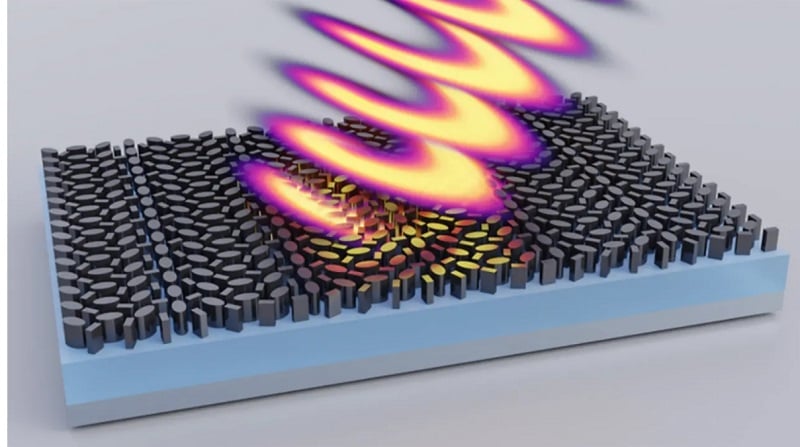
Thermal Metasurface Controls and Creates a Light Source
Optical metasurfaces offer the potential to shape and customize light for specific applications, but existing metasurfaces can only control laser light sources, and require bulky, expensive excitation setups to do so.
Researchers at City University of New York (CUNY) engineered a metasurface that can both produce and control its own thermal radiation. This advancement in 2D materials development could be used to create custom, compact, portable light sources for space, field research, and defense applications.
In previous work, the researchers theoretically showed that metasurfaces can be designed to shape the thermal radiation they generate, and that desirable features such as defined frequencies, custom polarization, and specific wavefront shapes can be introduced into the radiation.
The team experimentally validated this theory in its current research. It demonstrated polarization-selective, unidirectional, narrowband thermal emission generated within single-layer metasurfaces and showed that metasurfaces can precisely control the optical properties of thermal radiation generated within the metasurface itself.

A thermal metasurface is made of a single layer of nanostructured silicon (gray) on top of glass (blue) and a metal mirror (gold). The nanostructured surface is specifically tailored so that it thermally emits circularly polarized light to a desired direction. Courtesy of Adam Overvig.
To enable control of thermal emission, the researchers designed the metasurface to allow asymmetric emission of circularly polarized light toward a single direction. They implemented polarization gradients across the surface of the material to spread the photonic Rashba effect from circular polarizations to any pair of orthogonal polarizations, and applied this to thermal emission. They created a thermal geometric phase through pointwise specification of elliptical polarization, confirming that chiral emission is possible without breaking reciprocity.
The researchers simplified the architecture previously envisioned for the device, making the metasurface a single structured layer with a 2D pattern. With this streamlined design, the metasurface is easier to fabricate and more practical to implement.
Unlike laser light, which exhibits a well-defined frequency, polarization, and propagation direction, thermal emission has an incoherent, unpolarized nature, making it challenging to control. Advances in materials that interact with light have shown that patterned surfaces can transform thermal emission into partially coherent beams with tailored directionality and frequency selectivity.
“Our ultimate aim is enabling metasurface technology that does not require external laser sources, but can provide precise control over the way its own thermal radiation is emitted and propagates,” professor Adam Overvig, now at the Stevens Institute of Technology, said. “Our work is an important step in this quest, providing the foundation for a new class of metasurfaces that do not require external laser sources, but are fed by internal incoherent oscillations of matter driven by heat.”
The team said that its approach to developing optical metasurfaces that do not rely on external light sources can be used to enhance LED light sources, which are inexpensive and ubiquitous, but difficult to control.
The team aims to create more complex thermal emission patterns in the metasurfaces, such as a pattern that focuses thermal emission to a specific point above the device, and a pattern that can be used to build a thermal hologram. Such advancements could improve the design and functionality of custom light sources.
“Custom light sources are integral to a number of scientific and technological fields,” professor Andrea Alù said. “The ability to create compact, lightweight sources with desired spectral, polarization, and spatial features is particularly compelling for applications requiring portability, such as space-based technology, field research in geology and biology, and military operations.”
The research was published in Nature Nanotechnology (www.doi.org/10.1038/s41565-024-01763-6).
Published: September 2024